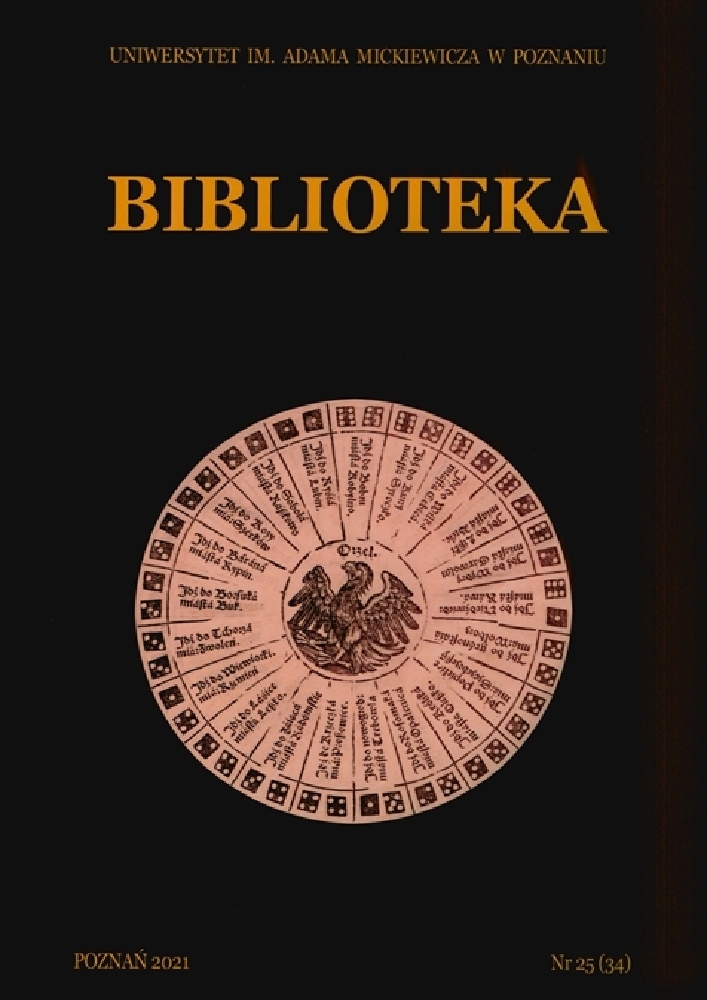Abstrakt
Cyfrowa nauka i presja na wykorzystanie cyfrowych narzędzi i metod w badaniach naukowych, nauczaniu czy wydawaniu publikacji naukowych stają się coraz bardziej zauważalną tendencją w naukach humanistycznych. Bibliotekom akademickim, pojmowanym jako laboratoria dla badaczy działających w dziedzinach humanistycznych (Christine Borgman), nie pozostaje więc nic innego, jak nadążyć za tymi zmianami. Humanistyka cyfrowa (HC) stała się istotnym obszarem bibliotekarstwa, a zapotrzebowanie na bibliotekarzy posiadających umiejętności i wiedzę potrzebne do tworzenia i zarządzania metadanymi, zarządzania cyfrowymi repozytoriami, organizacji informacji, zarządzania prawami własności intelektualnej, przechowywania i wizualizacji danych – zwiększa się niezmiennie. Artykuł koncentruje się na angielskojęzycznej literaturze przedmiotu przedstawiającej wizualizację danych przestrzennoczasowych w projektach HC poprzez bogaty zestaw narracji obejmujący teksty, interaktywne mapy oraz usługi z aktywnym monitorowaniem danych przestrzennych w kartografii cyfrowej. Na przykładzie projektów wykorzystujących kartografię cyfrową, opracowanych i zastosowanych w dużej bibliotece akademickiej, artykuł przedstawia, w jaki sposób wizualizacje danych przestrzennych i czasowych mogą być zastosowane w bibliotece akademickiej w celu promowania i informowania o zbiorach kartograficznych, którymi zainteresowani są badacze HC, oraz w jaki sposób biblioteka może dostarczyć swoim użytkownikom narzędzi do samodzielnej pracy.
Bibliografia
American Academy of Arts and Sciences. Bachelor’s Degrees in the Humanities. Humanities Indicators, 2021, https://tinyurl.com/bdh8dw93 [accessed: 24.06.2021].
Borgman Ch.L., The digital future is now: A call to action for the humanities, “Digital Humanities Quarterly” 2009, 3 (4), https://tinyurl.com/25zpjn43 [accessed: 22.06.2021].
Burdick A., Drucker J., Lunenfeld P., Presner T., Schnapp J., Digital Humanities, Cambridge, MA: MIT Press, 2012.
Drucker J., Visualization and interpretation: Humanistic approaches to display, MIT Press 2020.
Fitzparick K., The humanities, done digitally, “Chronicle of Higher Education” 2011, 57 (36), B26.
Gold M.K. (ed.), Debates in the digital humanities, Minneapolis, MN: University of Minnesota Press, 2012, https://tinyurl.com/3yuwctxm [accessed: 22.06.2021].
Heppler J.A., How people define digital humanities. What is digital humanities?, 2017, March 8, http://whatisdigitalhumanities.com [accessed: 22.06.2021].
Mathews B., Think like a startup: A white paper to inspire library entrepreneurialism, 2012, April 11, https://vtechworks.lib.vt.edu/handle/10919/18649 [accessed: 22.06.2021].
Poremski M.D., Evaluating the landscape of digital humanities librarianship, “College and Undergraduate Libraries” 2017, 24 (2–4), pp. 140–154. DOI: http://doi.org/10.1080/10691316.2017.1325721.
Posner M., Digital humanities 101: Introduction to digital humanities, 2016, http://miriamposner.com/classes/dh101f16/ [accessed: 22.06.2021].
Posner M., Introduction to digital humanities, 2017, http://miriamposner.com/classes/dh101f17/ [accessed: 22.06.2021].
Posner M., What are some challenges to doing DH in the Library? Miriam Posner’s Blog, 2012, August 10, http://miriamposner.com/blog/what-are-some-challenges-todoing-dh-in-the-library/ [accessed: 22.06.2021].
Schaffner J., Erway R., Does every research library need a Digital Humanities Center?, Dublin, Ohio: OCLC Research, 2014, https://tinyurl.com/bddyxday [accessed: 22.06.2021].
Sula C.A., Digital humanities and libraries: A conceptual model, “Journal of Library and Administration” 2013, 53 (1), pp. 10–26. DOI: http://doi.org/10.1080/01930826.2013.756680.
Thiede M., Preservation in practice: A survey of the New York City digital humanities researchers, “In the Library with the Lead Pipe” 2017, May 17, https://tinyurl.com/375n79t9 [accessed: 22.06.2021].
Licencja
Prawa autorskie (c) 2021 Maria A. Jankowska

Utwór dostępny jest na licencji Creative Commons Uznanie autorstwa – Na tych samych warunkach 4.0 Miedzynarodowe.
Utwory opublikowane w czasopiśmie Biblioteka, na platformie Pressto należącej do Uniwersytetu im. Adama Mickiewicza w Poznaniu od 2015 roku są udostępniane na
licencji Creative Commons Uznanie autorstwa-Na tych samych warunkach 4.0 Międzynarodowe.
Tym samym wszyscy zainteresowani są uprawnieni do korzystania z utworów opublikowanych po 2015 roku pod następującymi warunkami:
- uznania autorstwa czyli obowiązek podania wraz z rozpowszechnianym utworem informacji o autorstwie, tytule, źródle (odnośniki do oryginalnego utworu, doi) oraz samej licencji
- na tych samych warunkach — remiksując utwór, przetwarzając go lub tworząc na jego podstawie, należy swoje dzieło rozpowszechniać na tej samej licencji, co oryginał.
Uniwersytet im. Adama Mickiewicza w Poznaniu zachowuje prawo do czasopisma jako całości (układ, forma graficzna, tytuł, projekt okładki, logo itp.).
Autor zachowuje prawa majątkowe, ale udziela zgody Uniwersytetowi im. Adama Mickiewicza w Poznaniu na wykorzystanie dzieła. Autorzy tekstów zakwalifikowanych do publikacji proszeni są o wypełnienie podpisanie i przesłanie umowy.
Jeżeli autor artykułu nie jest przekonany, że może wykorzystywać cudze utwory (np. ilustracje, fotografie, tabele) w ramach cytatu we własnej tekście musi dostarczyć do redakcji czasopisma zgodę od uprawnionych podmiotów.
Prawa są zastrzeżone do wszystkich tekstów opublikowanych przed rokiem 2015.






